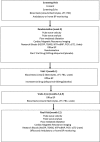Allopurinol treatment adversely impacts left ventricular mass regression in patients with well-controlled hypertension
- PMID: 31268872
- PMCID: PMC6855336
- DOI: 10.1097/HJH.0000000000002189
Allopurinol treatment adversely impacts left ventricular mass regression in patients with well-controlled hypertension
Abstract
Objectives: Previous studies have demonstrated that high-dose allopurinol is able to regress left ventricular (LV) mass in cohorts with established cardiovascular disease. The aim of this study was to assess whether treatment with high-dose allopurinol would regress LV mass in a cohort with essential hypertension, LV hypertrophy and well-controlled blood pressure but without established cardiovascular disease.
Methods: We conducted a mechanistic proof-of-concept randomized, placebo-controlled, double-blind trial of allopurinol (600 mg/day) versus placebo on LV mass regression. Duration of treatment was 12 months. LV mass regression was assessed by Cardiac Magnetic Resonance. Secondary outcomes were changes in endothelial function (flow-mediated dilatation), arterial stiffness (pulse wave velocity) and biomarkers of oxidative stress.
Results: Seventy-two patients were randomized into the trial. Mean baseline urate was 362.2 ± 96.7 μmol/l. Despite good blood pressure control, LV mass regression was significantly reduced in the allopurinol cohort compared with placebo (LV mass -0.37 ± 6.08 versus -3.75 ± 3.89 g; P = 0.012). Oxidative stress markers (thiobarbituric acid reactive substances) were significantly higher in the allopurinol group versus placebo (0.26 ± 0.85 versus -0.34 ± 0.83 μmol/l; P = 0.007). Other markers of vascular function were not significantly different between the two groups.
Conclusion: Treatment with high-dose allopurinol in normouricemic controlled hypertensive patients and LV hypertrophy is detrimental. It results in reduced LV mass regression and increased oxidative stress over a 12-month period. This may be because of an adverse impact on redox balance. Cohort selection for future cardiovascular trials with allopurinol is crucial.
Trial registration: ClinicalTrials.gov NCT02237339.
Figures
Comment in
-
Adverse cardiovascular effects of allopurinol are related to the use of high doses.J Hypertens. 2020 Jan;38(1):176-177. doi: 10.1097/HJH.0000000000002218. J Hypertens. 2020. PMID: 31790020 No abstract available.
-
Reply.J Hypertens. 2020 Jan;38(1):177-178. doi: 10.1097/HJH.0000000000002219. J Hypertens. 2020. PMID: 31790021 No abstract available.
References
-
- Cuspidi C, Meani S, Sala C, Valerio C, Negri F, Mancia G. Age related prevalence of severe left ventricular hypertrophy in essential hypertension: echocardiographic findings from the ETODH study. Blood Press 2012; 21:139–145. - PubMed
-
- Gosse P. Left ventricular hypertrophy--the problem and possible solutions. J Int Med Res 2005; 33 Suppl 1:3A–11A. - PubMed
-
- George J, Carr E, Davies J, Belch JJF, Struthers A. High-dose allopurinol improves endothelial function by profoundly reducing vascular oxidative stress and not by lowering uric acid. Circulation 2006; 114:2508–2516. - PubMed
-
- Rekhraj S, Gandy SJ, Szwejkowski BR, Nadir MA, Noman A, Houston JG, et al. High-dose allopurinol reduces left ventricular mass in patients with ischemic heart disease. J Am Coll Cardiol 2013; 61:926–932. - PubMed
Publication types
MeSH terms
Substances
Associated data
Grants and funding
LinkOut - more resources
Full Text Sources
Medical




